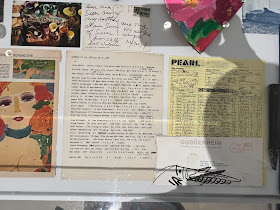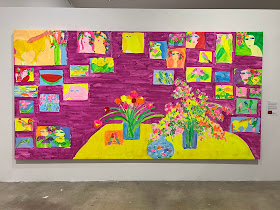Because a hot pink introduction is not a daily thing elsewhere, and it's perfect for Ting's work.
Who was Walasse Ting (1929, Wuxi, China; 2010, New York, NY)? We know he moved from China to Paris, met and hung out with Cobra members before moving to New York. I read he encouraged Vivian Springford's abstractions in the 1950s, and was friends with Sam Francis. He lived in my apartment building! All of this and more caught my interest and fascination. Ting named himself Walasse, combining his childhood name 'spoiled'/Hua-la-si + Matisse!
Throughout the exhibition there were several display tables of ephemera, delicious, valuable memories of old New York and artist affiliations.
Letter from Carnegie Institute
A Pearl receipt! Ting was unafraid to run up a bill.
The list to the left of receipt: artists' contact information with whom Ting shared an exhibition.
His spirit shines through: on one hand calligraphy and on another irreverent images of body parts.
Rice paper mounted on canvas in the French style 'marouflage,' adapting Chinese ink and acrylic. The acrylic does not respond with the agility of the ink, but Ting manages large, bright areas that glow.
Lower left: letter to daughter Mia at Westbeth! So cool to see.
Sketches
Such a great spirit, huge joy in color
Perhaps the most subtle and beautiful marouflage work.
Purple Studio, 1993, an homage to Ting's idol Matisse's Red Studio of 1911.
A result from a painting session with Sam Francis!
Ting's work in oil, which I felt was his best. Despite the thick paint, there is an airiness and spontaneity in his application. I Take My Pants Off Facing Sunset, 1969, acrylic on canvas.
Love Me With Your Heart That I Want, 1975
Miss World, 1975, acrylic on canvas, 12.5x7.5 feet: honoring pornography at its peak.
Detail
Raindrops on my Eyes, 1974
I Man Fountain, 1966
We now pivot to the early work, as I traveled through the exhibition backward. Pekin Opera, 1955, ink and oil on paper mounted on canvas. Showing the influence of his friend Pierre Aleschinsky.
Chinese City, oil on canvas, 1959--a simply gorgeous adaptation of ink to oil--and the show makes clear the artist's devotion to living between cultures, places, and approaches to paint. As history evolves we will witness more of this diasporic thinking--in which the diaspora is not tied to a specific place but becomes its own location.
My Memory is Too Much, 1958, oil on paper
"When you look at mountains, you imagine yourself being mountains; tigers and deer will skip under your armpits; when you see the ocean, you become the ocean; whale, tiger grouper, yellow croaker, and goldfish will swim in your mouth; when you see a tree, you are a tree, shooting up from the ground; cherries, plums, and lychees are falling from your arms. How do transformations happen? Think of the cloud and rain in the sky, they split and join, join and split. Splitting is expressive, to divide oneself into a thousand pieces." Wallace ting, 1973
Three Tang Era Women, 1960s; the titanium white perhaps his foray into acrylic on rice paper.
Early in Ting's US tenure, he took a ceramics course, focusing on ancient Chinese forms such as "marital boxes" ~ these works capture his charm
Two collaborations, above and below, with Pierre Alechinsky whom he met after arriving in Paris in 1963.
In 1953 arrived in
Paris. Six months later meet Pierre
Alechinsky. Six months later meet
Asger Jorn. Six months later meet
Karl Appel; drink coffe with them in Paris-Cafe. Working all kinds of job
to making a very simple living. Living
in a six inches window room. Paint
there, eat there.
How I adored this business letter discussing the value of his work, which Ting drew upon. Love his attitude.
Botticelli's Birth of Venus conceptualized as an umbrella, 1966. My favorite painting in the show--insouciant, light, poured, yet drawn. "Ting's poetry and painting often reference the Chinese metaphor of rain and clouds as symbolizing intercourse, and the shared space under an umbrella as a point of intimacy." "SOMEONE MAKE LOVE/HIDE INSIDE CLOUDS/STICK RAIN DROPS/LIKE BABIES, Ting wrote in Green Banana, 1971.



































No comments:
Post a Comment
Note: Only a member of this blog may post a comment.